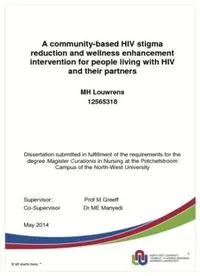
A community-based HIV stigma reduction and wellness enhancement intervention for people living ... PDF
Preview A community-based HIV stigma reduction and wellness enhancement intervention for people living ...
A community-based HIV stigma reduction and wellness enhancement intervention for people living with HIV and their partners MH Louwrens 12565318 Dissertation submitted in fulfillment of the requirements for the degree Magister Curationis in Nursing at the Potchefstroom Campus of the North-West University Supervisor: Prof M Greeff Co-Supervisor Dr ME Manyedi May 2014 TABLE OF CONTENTS LANGUAGE EDITOR’S DECLARATION ....................................................................... v TURN-IT-IN REPORT..................................................................................................... vi LIST OF ABBREVIATIONS ......................................................................................... viii RESEARCH OUTLINE ................................................................................................... ix ACKNOWLEDGEMENTS ............................................................................................... x AUTHOR’S CONTRIBUTION ........................................................................................ xi SUMMARY .................................................................................................................... xii OPSOMMING ............................................................................................................... xiii SECTION A: OVERVIEW OF THE RESEARCH ............................................................ 1 1 Introduction and Problem Statement .......................................................... 1 2 Research Objectives .................................................................................... 6 3 Paradigmatic Perspective ............................................................................ 6 3.1 Meta-theoretical assumptions .................................................................... 7 3.1.1 Person........................................................................................................... 7 3.1.2 Environment ................................................................................................. 7 3.1.3 Health ............................................................................................................ 8 3.1.4 Illness ........................................................................................................... 8 3.1.5 Nursing ......................................................................................................... 8 3.2 Theoretical statements ................................................................................ 9 3.2.1 Central theoretical argument ...................................................................... 9 3.2.2 Conceptual definitions ................................................................................ 9 3.3 Methodological statements ....................................................................... 10 i 4 Research Methodology .............................................................................. 11 4.1 Literature review ........................................................................................ 11 4.2 Research design ........................................................................................ 12 4.3 Research method ....................................................................................... 12 4.3.1 Phase 1: A holistic multiple case study of the community-based HIV stigma reduction intervention with PLHA and their partners ......... 12 4.3.2 Phase 2: Qualitative interpretive description of the lived experiences of PLHA and their partners during and after the community-based HIV stigma reduction intervention ............................ 17 4.3.3 Data-analysis .............................................................................................. 19 5 Trustworthiness .......................................................................................... 20 6 Ethical Considerations ............................................................................... 21 6.1 Quality of the research .............................................................................. 21 6.2 Consent ...................................................................................................... 22 6.3 Benefits and risks ...................................................................................... 22 7 Summary ..................................................................................................... 22 8 References .................................................................................................. 23 SECTION B: LITERATURE REVIEW ........................................................................... 27 1 Introduction ................................................................................................. 27 2 The Impact of HIV and AIDS ....................................................................... 28 3 Stigma in Context ....................................................................................... 29 3.1 Stigma definition ........................................................................................ 30 3.2 Stigma models ........................................................................................... 32 4 The Stigma Process ................................................................................... 33 ii 4.1 Triggers of stigma ..................................................................................... 33 4.2 Stigmatising behaviour ............................................................................. 34 4.3 Stigma types .............................................................................................. 34 4.4 Stigma outcomes ....................................................................................... 36 5 HIV and AIDS Stigma Reduction Interventions ........................................ 38 5.1 General interventions ................................................................................ 39 5.2 Community-based interventions .............................................................. 41 5.3 Interventions with partners of PLHA ........................................................ 43 6 Urban and Rural Differences in HIV Stigma Experiences ....................... 45 7 Conclusion .................................................................................................. 45 8 References .................................................................................................. 46 SECTION C: ARTICLE ................................................................................................. 52 Guidelines for Africa Journal of Nursing and midwifery .......................................... 53 SECTION D: CONCLUSIONS, LIMITATIONS AND RECOMMENDATIONS ............... 81 1 Conclusions ................................................................................................ 81 2 Limitations................................................................................................... 82 3 Recommendations ...................................................................................... 83 iii LIST OF APPENDIXES APPENDIX A: ETHICAL APPROVAL FOR THE STUDY ............................................ 84 APPENDIX B: CONSENT TO BE A RESEARCH PARTICIPANT................................ 85 APPENDIX C: EXAMPLE OF A NAÏVE SKETCH ........................................................ 88 APPENDIX D: EXAMPLE OF A FIELD NOTE ............................................................. 89 APPENDIX E: SECTION OF AN IN-DEPTH INTERVIEW ............................................ 91 LIST OF TABLES Table 1: Standards, strategies and criteria to ensure trustworthiness................... 20 iv LANGUAGE EDITOR’S DECLARATION v TURN-IT-IN REPORT vi Turn-it-in (TII) process notes Document eFundi site Date of % Comment/ Signature submitted submitted submission similarity motivation by supervisor through on TII supervisor or co- report supervisor Literature AUTHeR 2013-04-16 71% Due to high study percentage overlap/similarity, revisions needed to re-formulate original source into own words. All similarities were accurately references, but student didn‘t integrate source into own language and word order is too similar to sources. Literature AUTHeR 2013-08-22 44% Restructuring of study: re- sentences to re- submission formulate working of similar section was completed. Literature AUTHeR 2013-08-22 22% Final revisions to study: re- literature study made: submission sources that were changed were excluded. Result is satisfactory. vii LIST OF ABBREVIATIONS AIDS Acquired Immune Deficiency Syndrome HIV Human Immunodeficiency Virus NGO Non-Governmental Organization NWU North-West University PLHA People living with HIV and AIDS viii RESEARCH OUTLINE The research is presented in an article format and includes the following: Section A: An overview of the research The purpose of the overview is to provide a brief literature review that led to the study, the paradigmatic perspective and a comprehensive overview of the planned research. More detail is provided here than possible in the article in section C. Section B: Literature review The purpose of the literature review is to present a critical synthesis of aspects that best support the case study and interpretive description approach. The literature review allows for a critical reflection on what literature does and does not contain, commentary on the strengths and weaknesses within the overall body of knowledge, as well as identifying gaps in the knowledge base. Section C: The article The article reports on the findings of the research. ARTICLE TITLE JOURNAL SUBMITTED TO A community-based HIV stigma reduction Africa Journal of Nursing and intervention for people living with HIV and their Midwifery partners Section D: Conclusions, limitations and recommendations This section presents the overall conclusions, limitations of the study discussed and recommendations for further research presented. ix
